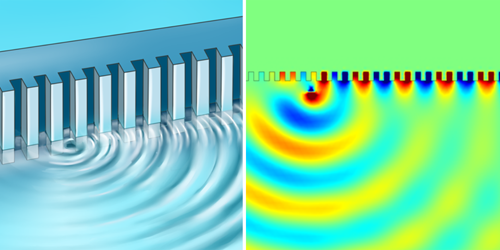Metamaterials Control the Shape of Water Waves
The ability of metamaterials to steer light has enabled amazing inventions from superresolution microscopes to “invisiblity” cloaks. But the physics underlying these structures also applies to other waves, such as acoustic, seismic, and water waves. Huanyang Chen and his colleagues at Xiamen University in China have demonstrated a structure that can change the propagation of surface water waves, making a localized wave that is analogous to an electromagnetic excitation called a surface plasmon polariton [1].
Surface plasmon polaritons occur at the interface between a dielectric and a negative-permittivity material such as a metal. Generating an equivalent excitation in surface water waves requires a similar sort of interface, such as that between water and a vertical barrier. In this case, the water’s parameter that is analogous to a metal’s permittivity is its depth. Of course, it’s impossible for water to have negative depth, but using metamaterials, Chen and his colleagues engineered the boundary conditions of the waves to achieve the same effect.
The team printed a 3D plastic barrier patterned with thin, vertical grooves. They stood the barrier in a tub of water and, using a submerged screw propeller, produced waves that crashed against the grooves. After hitting the grooved surface, the waves propagated parallel to the barrier as a series of localized surface-plasmon-polariton-like excitations. These excitations traveled in only one direction along the barrier, going either left or right depending on the direction of the propeller’s rotation.
Chen is interested in exploring the use of metamaterials to effectively change other parameters—such as gravity—that control the behavior of water waves and in making materials with a negative index of refraction. He thinks such research could inspire new methods for water management.
–Katie McCormick
Katie McCormick is a freelance science writer based in Sacramento, California.
References
- L. Han et al., “Water wave polaritons,” Phys. Rev. Lett. 128, 204501 (2022).




